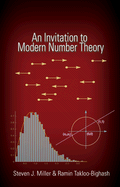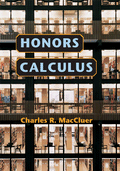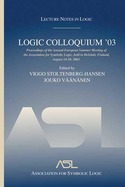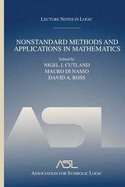Steven J. Miller and Ramin Takloo-Bighash
An Invitation to Modern Number Theory
 Cloth | April 2006 | ISBN: 0-691-12060-9
Cloth | April 2006 | ISBN: 0-691-12060-9
519 pp. | 6 x 9 | 20 line illus.
In a manner accessible to beginning undergraduates, An Invitation
to Modern Number Theory introduces many of the central problems,
conjectures, results, and techniques of the field, such as the
Riemann Hypothesis, Roth's Theorem, the Circle Method, and Random
Matrix Theory. Showing how experiments are used to test
conjectures and prove theorems, the book allows students to do
original work on such problems, often using little more than
calculus (though there are numerous remarks for those with deeper
backgrounds). It shows students what number theory theorems are
used for and what led to them and suggests problems for further
research.
Steven Miller and Ramin Takloo-Bighash introduce the problems and
the computational skills required to numerically investigate
them, providing background material (from probability to
statistics to Fourier analysis) whenever necessary. They guide
students through a variety of problems, ranging from basic number
theory, cryptography, and Goldbach's Problem, to the algebraic
structures of numbers and continued fractions, showing
connections between these subjects and encouraging students to
study them further. In addition, this is the first undergraduate
book to explore Random Matrix Theory, which has recently become a
powerful tool for predicting answers in number theory.
Providing exercises, references to the background literature, and
Web links to previous student research projects, An Invitation to
Modern Number Theory can be used to teach a research seminar or a
lecture class.
Steven J. Miller is an Assistant Professor of Mathematics at
Brown University. Ramin Takloo-Bighash is an Assistant Professor
of Mathematics at Princeton University.
Endorsements:
"The book provides a much-needed introduction to modern
number theory that emphasizes analytic number theory. It should
serve remarkably well as an advanced undergraduate textbook and
its latter parts would be suitable for a beginning graduate
course. Some of the material covered, such as the circle method
and random matrix theory, is not readily available elsewhere in
book form. These topics provide terrific examples of areas in
number theory of great current interest that can be penetrated by
students. I would seriously consider using this book in my own
classes and recommend it with enthusiasm for highly motivated
students."--William Duke, University of California, Los
Angeles
"Having this selection of material available in essentially
self-contained form is fantastic. Reading the book (or taking a
class based on it) might easily decide the future endeavors of
many a neophyte mathematician. I have yet to discover a clearer
exposition of the works of the circle method. The inclusion of
exercises and, especially, of problems for further research and
theoretical or numerical exploration is extremely valuable. I
would dare to compare the book to Hardy and Wright's classic An
Introduction to the Theory of Numbers in that Miller and Takloo-Bighash
expose readers to the lively work of number theory, to its
proofs, ideas, and methods, assuming only a very modest
background."--Eduardo Duenez, University of Texas, San
Antonio
Table of Contents
l
*
Charles R. MacCluer
Honors Calculus
 Cloth | May 2006 | ISBN: 0-691-12533-3
Cloth | May 2006 | ISBN: 0-691-12533-3
200 pp. | 7 x 10 | 38 line illus.
This is the first modern calculus book to be organized
axiomatically and to survey the subject's applicability to
science and engineering. A challenging exposition of calculus in
the European style, it is an excellent text for a first-year
university honors course or for a third-year analysis course. The
calculus is built carefully from the axioms with all the standard
results deduced from these axioms. The concise construction, by
design, provides maximal flexibility for the instructor and
allows the student to see the overall flow of the development. At
the same time, the book reveals the origins of the calculus in
celestial mechanics and number theory.
The book introduces many topics often left to the appendixes in
standard calculus textbooks and develops their connections with
physics, engineering, and statistics. The author uses
applications of derivatives and integrals to show how calculus is
applied in these disciplines. Solutions to all exercises (even
those involving proofs) are available to instructors upon
request, making this book unique among texts in the field.
*Focuses on single variable calculus
*Provides a balance of precision and intuition
*Offers both routine and demanding exercises
Professors: A supplementary Solutions Manual is available for
this book. It is restricted to teachers using the text in courses.
For information on how to obtain a copy, refer to: http://pup.princeton.edu/solutions.html
Charles R. MacCluer is Professor of Mathematics and director of
the industrial mathematics program at Michigan State University.
His first interest was algebraic number theory but later turned
to the more practical disciplines of control theory, signal
processing, building science, and industrial problems. He is the
author of Industrial Mathematics, Boundary Value Problems and
Fourier Expansions, and Calculus of Variations.
Viggo Stoltenberg-Hansen (Editor), Jouko Vaananen (Editor)
Logic Colloquium f03
 Lecture Notes in Logic 24
Lecture Notes in Logic 24
Summary
A compilation of papers presented at the 2003 European Summer
Meeting of the Association for Symbolic Logic, Logic Colloquium
f03 includes tutorials and research articles from some of the
worldfs preeminent logicians. One article is a tutorial on
finite model theory and query languages that lie between first
order and second order logic. The other articles cover current
research topics in all areas of mathematical logic, including
Proof Theory, Set Theory, Model Theory, and Computability Theory,
and Philosophy.
Details
ISBN: 1-56881-293-0
Year: 2006
Format: Hardcover
Pages: 417
ISBN: 1-56881-294-9
Year: 2006
Format: Paperback
Pages: 412
Nigel J. Cutland (Editor), Mauro Di Nasso (Editor), David A. Ross (Editor)
Nonstandard Methods and Applications in Mathematics
 Lecture Notes in Logic 25
Lecture Notes in Logic 25
Summary
A conference on Nonstandard Methods and Applications in
Mathematics (NS2002) was held in Pisa, Italy from June 12-16,
2002. Nonstandard analysis is one of the great achievements of
modern applied mathematical logic. In addition to the important
philosophical achievement of providing a sound mathematical basis
for using infinitesimals in analysis, the methodology is now well
established as a tool for both research and teaching, and has
become a fruitful field of investigation in its own right. This
book is a collection of peer-reviewed papers solicited from some
of the participants of this conference with the aim of providing
something more timely than a textbook, but less ephemeral than a
conventional proceedings. It contains both survey papers and
research articles with special consideration for one, gNonstandard
analysis at pre-university level: naive magnitude analysish in
which the author discusses his experience teaching calculus
through an infinitesimal approach.
Details
ISBN: 1-56881-291-4
Year: 2006
Format: Hardcover
Pages: 262
ISBN: 1-56881-292-2
Year: 2006
Format: Paperback
Pages: 262
Bernstein, Joseph; Hinich, Vladimir; Melnikov, Anna (Eds.)
Studies in Lie Theory
Dedicated to A. Joseph on his Sixtieth Birthday
 Series: Progress in Mathematics, Vol. 243
Series: Progress in Mathematics, Vol. 243
2006, XXII, 494 p. 2 illus., Hardcover
ISBN: 0-8176-4342-7
About this book
Dedicated to Anthony Joseph, this volume contains surveys and invited articles by leading specialists in representation theory. The focus here is on semisimple Lie algebras and quantum groups, where the impact of Joseph's work has been seminal and has changed the face of the subject.
Two introductory biographical overviews of Joseph's contributions in classical representation theory (the theory of primitive ideals in semisimple Lie algebras) and quantized representation theory (the study of the quantized enveloping algebra) are followed by 16 research articles covering a number of varied and interesting topics in representation theory.
Contributors: J. Alev; A. Beilinson; A. Braverman; I. Cherednik; J. Dixmier; F. Dumas; P. Etingof; D. Farkas; D. Gaitsgory; F. Ivorra; A. Joseph; D. Joseph; M. Kashiwara; D. Kazhdan; A.A. Kirillov; B. Kostant; S. Kumar; G. Letzter; T. Levasseur; G. Lusztig; L. Makar-Limanov; W. McGovern; M. Nazarov; K-H. Neeb; L.G. Rybnikov; P. Schapira; V. Schechtman; A. Sergeev; J.T. Stafford; Ya. Varshavsky; N. Wallach; and I. Waschkies.
Table of contents
* Preface
* Publications of Anthony Joseph
* Students of Anthony Joseph
* From Denise Joseph
* From Jacques Dixmier: A Recollection of Tony Joseph
Part I: Survey and Review
* W. McGovern: The work of Anthony Joseph in classical representation theory
* D. Farkas and G. Letzter: Quantized representation theory following Joseph
Part II: Research Articles
* J. Alev and F. Dumas: Operateurs differentiels invariants et probleme de Noether
* A. Beilinson: Langlands parameters for Heisenberg modules
* A. Braverman and P. Etingof: Instanton counting via affine Lie algebras II: From Whittaker vectors to the Seiberg?Witten prepotential
* I. Cherednik: Irreducibility of perfect representations of double affine Hecke algebras
* D. Gaitsgory and D. Kazhdan: Algebraic groups over a 2-dimensional local field: Some further constructions
* A. Joseph: Modules with a Demazure flag
* M. Kashiwara, P. Schapira, F. Ivorra, and I. Waschkies: Microlocalization of ind-sheaves
* D. Kazhdan and Ya. Varshavsky: Endoscopic decomposition of certain depth zero representations
* A.A. Kirillov and L.G. Rybnikov: Odd family algebras
* B. Kostant and N. Wallach: Gelfand?Zeitlin theory from the perspective of classical mechanics I
* S. Kumar and K-H. Neeb: Extensions of algebraic groups
* T. Levasseur and J.T. Stafford: Differential operators and cohomology groups on the basic affine space
* G. Lusztig: A q-analogue of an identity of N. Wallach
* L. Makar-Limanov: Centralizers in the quantum plane algebra
* M. Nazarov and A. Sergeev: Centralizer construction of the Yangian of the queer Lie superalgebra
* V. Schechtman: Definitio nova algebroidis verticiani
 Cloth | April 2006 | ISBN: 0-691-12060-9
Cloth | April 2006 | ISBN: 0-691-12060-9 Cloth | May 2006 | ISBN: 0-691-12533-3
Cloth | May 2006 | ISBN: 0-691-12533-3 Lecture Notes in Logic 24
Lecture Notes in Logic 24  Lecture Notes in Logic 25
Lecture Notes in Logic 25  Series: Progress in Mathematics, Vol. 243
Series: Progress in Mathematics, Vol. 243